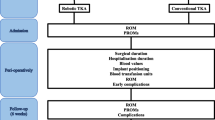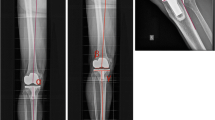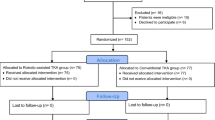Abstract
Purpose
The aim of this study was (1) to compare the clinical and radiological outcomes of robotic and conventional total knee arthroplasty with a minimum follow-up of ten years, (2) to evaluate the survival rate, (3) and to estimate the accuracy of the two techniques by analyzing the outliers of the total knee arthroplasty (TKA) patients.
Methods
We evaluated 351 patients (390 knees), 155 patients undergoing robotic TKA, and 196 patients treated with conventional TKA with a mean follow-up of 11.0 years. HSS, KSS, WOMAC, and SF-12 questionnaires were used for clinical evaluation. Mechanical alignment, implant radiological measurements, and outliers were analyzed for radiological results. Kaplan-Meier survival analysis was performed for survival rate.
Results
All clinical assessments showed excellent improvements in both groups (all p < 0.05), without any significant difference between the groups (p > 0.05). The conventional TKA group showed a significantly higher number of outliers compared with the robotic TKA group (0 < 0.05). The cumulative survival rate was 98.8% in the robotic TKA group and 98.5% in the conventional TKA group with excellent survival (p = 0.563).
Conclusion
Our study showed excellent survival with both robotic and conventional TKA and similar clinical outcomes at long-term follow-up. And, in terms of radiological outcome, robotic TKA showed better accuracy and consistency with fewer outliers compared with conventional TKA. With longer follow-up and larger cohort, the accuracy and effectiveness of robotic TKA on implant survival rate can be elucidated in the future.




Similar content being viewed by others
References
Attar FG, Khaw FM, Kirk LM, Gregg PJ (2008) Survivorship analysis at 15 years of cemented press-fit condylar total knee arthroplasty. J Arthroplast 23:344–349
Carr AJ, Robertsson O, Graves S, Price AJ, Arden NK, Judge A et al (2012) Knee replacement. Lancet 379:1331–1340
Sharkey PF, Lichstein PM, Shen C, Tokarski AT, Parvizi J (2014) Why are total knee arthroplasties failing today--has anything changed after 10 years? J Arthroplast 29:1774–1778
Fehring TK, Odum S, Griffin WL, Mason JB, Nadaud M (2001) Early failures in total knee arthroplasty. Clin Orthop 392:315–318
Rodriguez JA, Bhende H, Ranawat CT (2001) Total condylar knee replacement: a 20-year follow-up study. Clin Orthop Relat Res 388:10–17
Tingart M, Luring C, Bathis H, Beckmann J, Grifka J, Perlick L (2008) Computer-assisted total knee arthroplasty versus the conventional technique: how precise is navigation in clinical routine? Knee Surg Sports Traumatol Arthrosc 16:44–50
Spencer JM, Chauhan SK, Sloan K, Taylor A, Beaver RJ (2007) Computer navigation versus conventional total knee replacement: no difference in functional results at two years. J Bone Joint Surg (Br) 89:477–480
Dutton AQ, Yeo SJ (2009) Computer-assisted minimally invasive total knee arthroplasty compared with standard total knee arthroplasty. Surgical technique. J Bone Joint Surg Am 91(Suppl 2 Pt 1):116–130
Nakano N, Matsumoto T, Ishida K, Tsumura N, Kuroda R, Kurosaka M (2013) Long-term subjective outcomes of computer-assisted total knee arthroplasty. Int Orthop 37:1911–1915
Tolk JJ, Koot HW, Janssen RP (2012) Computer navigated versus conventional total knee arthroplasty. J Knee Surg 25:347–352
Unwin O, Hassaballa M, Murray J, Harries W, Porteous A (2017) Minimally invasive surgery (MIS) for total knee replacement; medium term results with minimum five year follow-up. Knee 24:454–459
Liow MHL, Goh GS, Wong MK, Chin PL, Tay DK, Yeo SJ (2017) Robotic-assisted total knee arthroplasty may lead to improvement in quality-of-life measures: a 2-year follow-up of a prospective randomized trial. Knee Surg Sports Traumatol Arthrosc 25(9):2942–2951
Liow MH, Chin PL, Tay KJ, Chia SL, Lo NN, Yeo SJ (2014) Early experiences with robot-assisted total knee arthroplasty using the DigiMatch ROBODOC(R) surgical system. Singap Med J 55(10):529–534
Oh KJ, Goodman SB, Yang JH (2011) Prospective, randomized study between insall-burstein II and NexGen legacy with a minimum 9-year follow-up. J Arthroplast 26:1232–1238
Song EK, Seon JK, Yim JH, Netravali NA, Bargar WL (2013) Robotic-assisted TKA reduces postoperative alignment outliers and improves gap balance compared to conventional TKA. Clin Orthop Relat Res 471:118–126
Winemaker MJ (2002) Perfect balance in total knee arthroplasty: the elusive compromise. J Arthroplast 17:2–10
Sugama R, Kadoya Y, Kobayashi A, Takaoka K (2005) Preparation of the flexion gap affects the extension gap in total knee arthroplasty. J Arthroplast 20:602–607
Insall JN, Ranawat CS, Aglietti P, Shine J (1976) A comparison of four models of total knee-replacement prostheses. J Bone Joint Surg Am 58:754–765
Insall JN, Dorr LD, Scott RD, Scott WN (1989) Rationale of the Knee Society clinical rating system. Clin Orthop Relat Res 248:13–14
Bellamy N, Buchanan WW, Goldsmith CH, Campbell J, Stitt LW (1988) Validation study of WOMAC: a health status instrument for measuring clinical important patient relevant outcomes to antirheumatic drug therapy in patients with osteoarthritis of the hip or knee. J Rheumatol 15:1833–1840
Ware JE Jr, Kosinski M, Keller SD (1996) A 12-item short-form health survey: construction of scales and preliminary tests of reliability and validity. Med Care 34:220–233
Chen JY, Chin PL, Tay DK, Chia SL, Lo NN, Yeo SJ (2014) Less outliers in pinless navigation compared with conventional surgery in total knee arthroplasty. Knee Surg Sports Traumatol Arthrosc 22(8):1827–1832
Shi J, Wei Y, Wang S, Chen F, Wu J, Huang G, Chen J, Wei L, Xia J (2014) Computer navigation and total knee arthroplasty. Orthopedics 37(1):e39–e43
Choong PF, Dowsey MM, Stoney JD (2009) Does accurate anatomical alignment result in better function and quality of life? Comparing conventional and computer-assisted total knee arthroplasty. J Arthroplast 24:560–569
Jeffery RS, Morris RW, Denham RA (1991) Coronal alignment after total knee replacement. J Bone Joint Surg (Br) 73:709–714
Perillo-Marcone A, Barrett DS, Taylor M (2000) The importance of tibial alignment: finite element analysis of tibial malalignment. J Arthroplast 15:1020–1027
Parratte S, Pagnano MW, Trousdale RT, Berry DJ (2010) Effect of postoperative mechanical axis alignment on the fifteen-year survival of modern, cemented total knee replacements. J Bone Joint Surg Am 92:2143–2149
Ishida K, Matsumoto T, Tsumura N, Kubo S, Kitagawa A, Chin T et al (2011) Mid-term outcomes of computer-assisted total knee arthroplasty. Knee Surg Sports Traumatol Arthrosc 19:1107–1112
Gøthesen O, Espehaug B, Havelin LI, Petursson G, Hallan G, Strøm E et al (2014) Functional outcome and alignment in computer-assisted and conventionally operated total knee replacements: a multicentre parallel-group randomised controlled trial. Bone Joint J 96-B:609–618
Herry Y, Batailler C, Lording T, Servien E, Neyret P, Lustig S (2017) Improved joint-line restitution in unicompartmental knee arthroplasty using a robotic-assisted surgical technique. Int Orthop 41(11):2265–2271
Turktas U, Piskin A, Poehling GG (2016) Short-term outcomes of robotically assisted patello-femoral arthroplasty. Int Orthop 40(5):919–924
Song EK, Seon JK, Park SJ, Jung WB, Park HW, Lee GW (2011) Simultaneous bilateral total knee arthroplasty with robotic and conventional techniques: a prospective, randomized study. Knee Surg Sports Traumatol Arthrosc 19(7):1069–1076
Huizinga MR, Brouwer RW, Bisschop R, van der Veen HC, van den Akker-Scheek I, van Raay JJ (2012) Long-term follow-up of anatomic graduated component total knee arthroplasty: a 15- to 20-year survival analysis. J Arthroplast 27:1190–1195
Bachmann M, Bolliger L, Ilchmann T, Clauss M (2014) Long-term survival and radiological results of the Duracon™ total knee arthroplasty. Int Orthop 38:747–752
Jauregui JJ, Cherian JJ, Pierce TP, Beaver WB, Issa K, Mont MA (2015) Long-term survivorship and clinical outcomes following total knee arthroplasty. J Arthroplast 30:2164–2166
Song EK, Agrawal PR, Kim SK, Seo HY, Seon JK (2017) A randomized controlled clinical and radiological trial about outcomes of navigation-assisted TKA compared to conventional TKA: long-term follow-up. Knee Surg Sports Traumatol Arthrosc 24(11):3381–3386
De Steiger RN, Liu YL, Graves SE (2015) Computer navigation for total knee arthroplasty reduces revision rate for patients less than sixty-five years of age. J Bone Joint Surg (Am) 97(8):635–642
Saragaglia D, Sigwalt L, Gaillot J, Morin V, Rubens-Duval B, Pailhé R (2017) Results with eight and a half years average follow-up on two hundred and eight e-motion FP® knee prostheses, fitted using computer navigation for knee osteoarthritis in patients with over ten degrees genu varum. Int Orthop 42(4):799–804
Bistolfi A, Lee GC, Deledda D, Rosso F, Berchialla P, Crova M, Massazza G (2014) NexGen LPS mobile bearing total knee arthroplasty: 10-year results. Knee Surg Sports Traumatol Arthrosc 22:1786–1792
Schiavone Panni A, Falez F, D'Apolito R, Corona K, Perisano C, Vasso M (2017) Long-term follow-up of a non-randomised prospective cohort of one hundred and ninety two total knee arthroplasties using the NexGen implant. Int Orthop 41:1155–1162
Kim YH, Park JW, Kim JS (2017) The clinical outcome of computer-navigated compared with conventional knee arthroplasty in the same patients: a prospective, randomized, double-blind, long-term study. J Bone Joint Surg (Am) 99(12):989–996
Cho KJ, Seon JK, Jang WY, Park CG, Song EK (2018) Objective quantification of ligament balancing using VERASENSE in measured resection and modified gap balance total knee arthroplasty. BMC Musculoskelet Disord 19(1):266–276
Marchand RC, Sodhi N, Khlopas A, Sultan AA, Harwin SF, Malkani AL, Mont MA (2017) Patient satisfaction outcomes after robotic arm-assisted total knee arthroplasty: a short-term evaluation. J Knee Surg 30(9):849–853
Hampp EL, Chughtai M, Scholl LY, Sodhi N, Bhowmik-Stoker M, Jacofsky DJ, Mont MA (2018) Robotic-arm assisted total knee arthroplasty demonstrated greater accuracy and precision to plan compared with manual techniques. J Knee Surg. https://doi.org/10.1055/s-0038-1641729
Kayani B, Konan S, Tahmassebi J, Pietrzak JRT, Haddad FS (2018) Robotic-arm assisted total knee arthroplasty is associated with improved early functional recovery and reduced time to hospital discharge compared with conventional jig-based total knee arthroplasty. Bone Joint J 100-B(7):930–937
Swank ML, Alkire M, Conditt M, Lonner JH (2009) Technology and cost-effectiveness in knee arthroplasty: computer navigation and robotics. Am J Orthop (Belle Mead NJ) 38(2 Suppl):32–36
Lonner JH, Smith JR, Picard F, Hamlin B, Rowe PJ, Riches PE (2015) High degree of accuracy of a novel image-free handheld robot for unicondylar knee arthroplasty in a cadaveric study. Clin Orthop Relat Res 473(1):206–212
Author information
Authors and Affiliations
Corresponding author
Ethics declarations
The retrospective randomized study was approved by institutional review board of Chonnam National University Hwasun Hospital and analysis was performed
Conflict of interest
On behalf of all authors, the corresponding author states that there is no conflict of interest.
Rights and permissions
About this article
Cite this article
Cho, KJ., Seon, JK., Jang, WY. et al. Robotic versus conventional primary total knee arthroplasty: clinical and radiological long-term results with a minimum follow-up of ten years. International Orthopaedics (SICOT) 43, 1345–1354 (2019). https://doi.org/10.1007/s00264-018-4231-1
Received:
Accepted:
Published:
Issue Date:
DOI: https://doi.org/10.1007/s00264-018-4231-1




